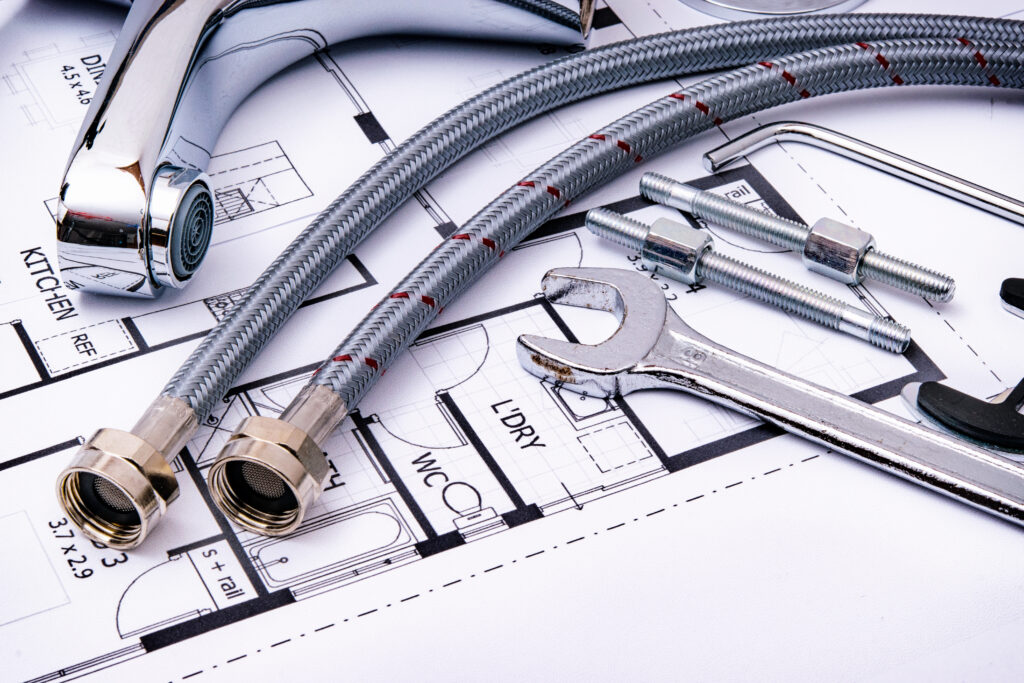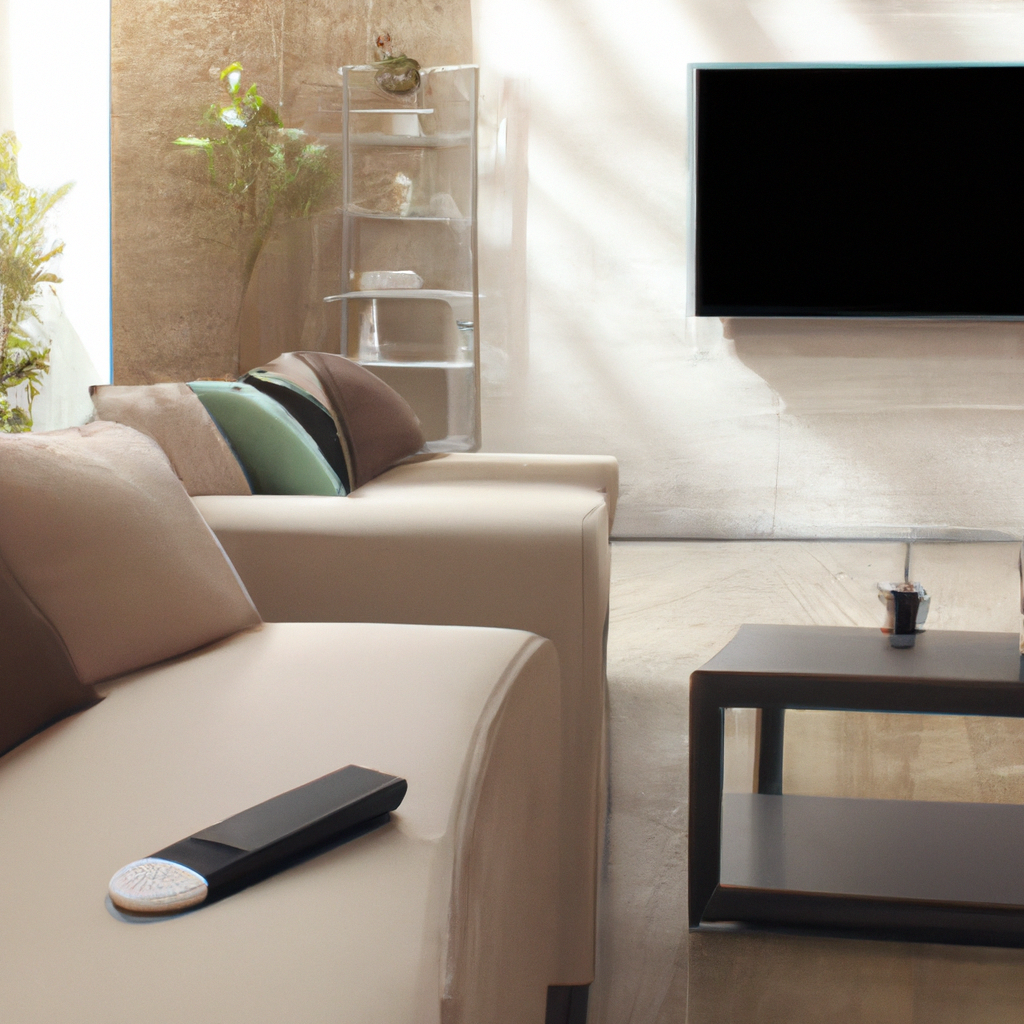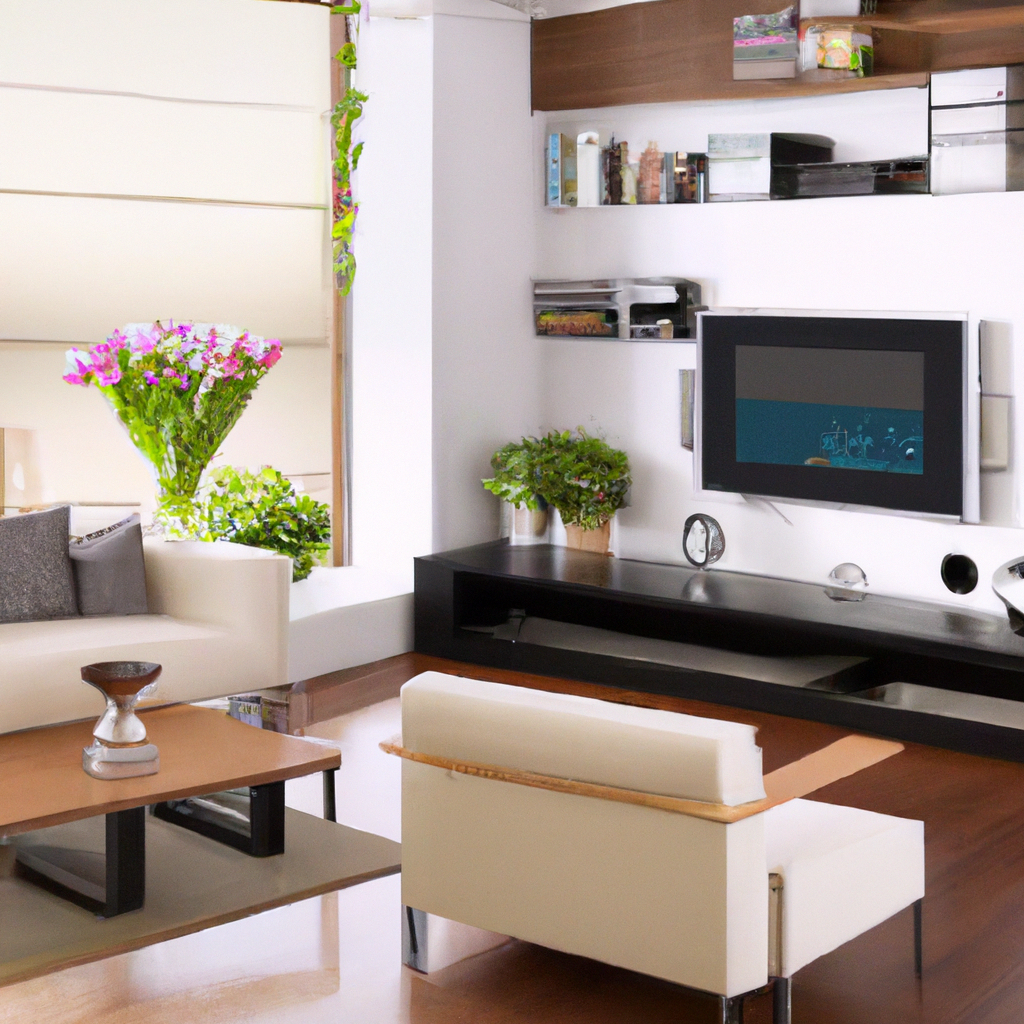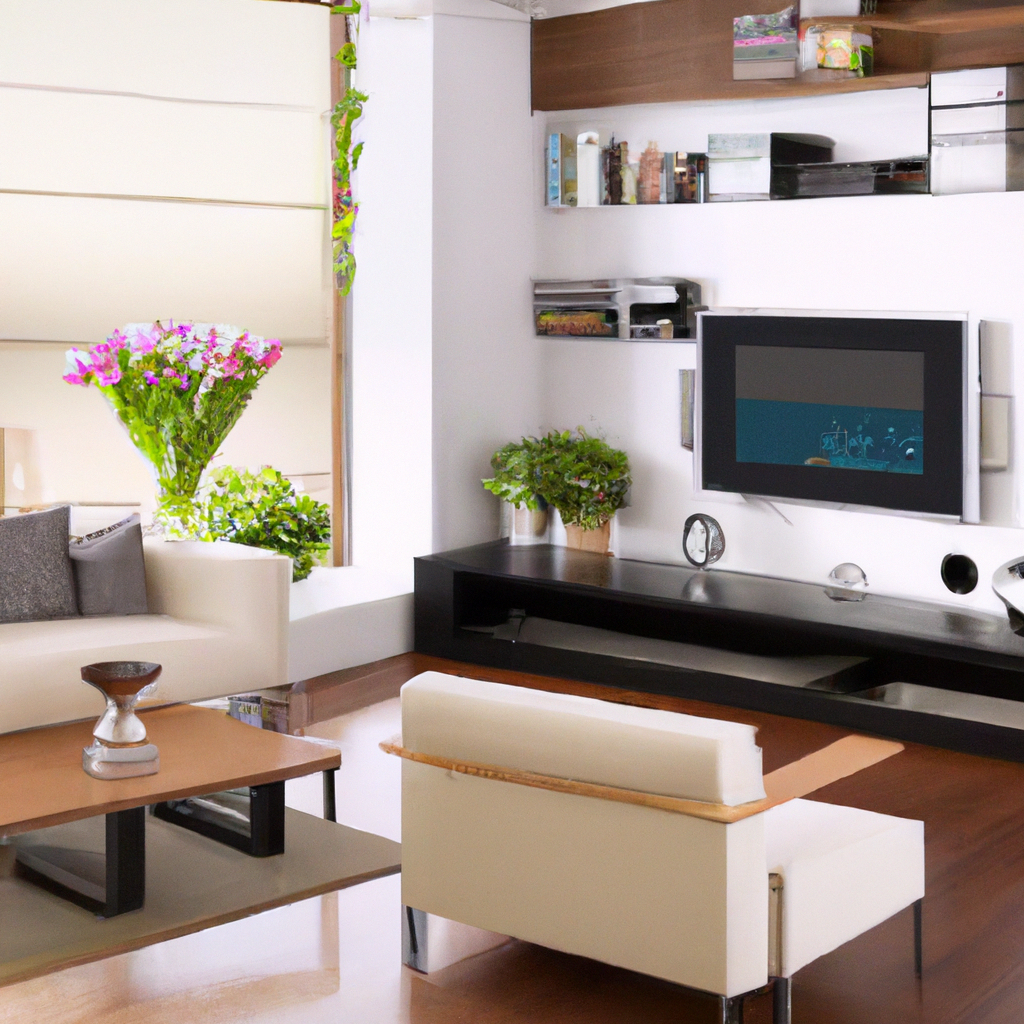Imagine you have a cozy living room, filled with all your favorite furniture and decorations. But there’s something missing – the smart features that make life easier and more convenient. If you’re wondering how to transform your non-smart living room into a modern haven without breaking the bank, you’ve come to the right place. In this article, we will explore the cost-effective options available for retrofitting your living room and bringing it into the smart era. Get ready to discover simple and affordable ways to upgrade your space and enhance your everyday living experience.

Smart Home Technology Options
Smart Speakers
One cost-effective option for retrofitting a non-smart living room is by incorporating smart speakers. These devices can be connected to your Wi-Fi network and often come with built-in voice assistants, such as Amazon Alexa or Google Assistant. Smart speakers allow you to control various aspects of your living room, such as playing music, turning on the lights, or adjusting the thermostat, just by using your voice. They can also be used to set reminders, create shopping lists, and answer questions. With their compact size and sleek designs, smart speakers blend seamlessly into any living room decor.
Smart Lighting
Upgrading your lighting system to smart lighting is another cost-effective option. Smart bulbs, like LED bulbs, can be controlled remotely via smartphone apps or voice commands. They offer various features such as adjustable brightness, color-changing capabilities, and scheduling options. With smart lighting, you can easily create different lighting scenes for different moods or occasions. For instance, you can set a cozy, warm ambiance for movie nights or bright, energizing lighting for social gatherings. Moreover, smart lighting can help you save energy and reduce your electricity bills by automatically turning off lights when not in use.
Smart Plugs and Power Strips
Smart plugs and power strips are great cost-effective solutions for retrofitting a non-smart living room. These devices allow you to transform your regular appliances into smart ones by simply plugging them into the smart plug or power strip. With a smart plug or power strip, you can control the power supply to your devices remotely through smartphone apps or voice assistants. For example, you can turn on your TV, coffee maker, or gaming console before even setting foot in the living room. Additionally, some smart plugs and power strips offer energy monitoring features, allowing you to track and optimize your energy usage.
Smart Thermostats
Smart thermostats are an excellent option for upgrading your living room’s temperature control system. These devices enable you to regulate the temperature of your living room from anywhere using your smartphone or voice commands. With their advanced sensors and learning capabilities, smart thermostats can adjust the temperature based on your preferences and schedule, ensuring optimal comfort and energy efficiency. They can also provide valuable insights into your energy usage and suggest ways to save on heating and cooling costs. Installing a smart thermostat can significantly enhance your living room’s comfort while helping you reduce your carbon footprint.
Upgrading Entertainment System
Smart TV
Upgrading to a smart TV is a key component in retrofitting a non-smart living room. Smart TVs come with built-in Wi-Fi capabilities and pre-installed streaming apps, allowing you to access a wide array of online content directly from your TV. You can stream your favorite movies, TV shows, and music services without needing an external device such as a media player or a gaming console. Smart TVs also offer features like screen mirroring, voice control, and compatibility with other smart home devices. Additionally, they can be connected to your home network, enabling seamless integration with other smart devices in your living room.
Streaming Devices
If you already have a non-smart TV, a cost-effective option for enjoying smart features is to add a streaming device. Streaming devices, such as Amazon Fire TV Stick, Roku, or Google Chromecast, connect to your TV via HDMI and provide access to various streaming services, apps, and games. They essentially turn your regular TV into a smart TV by allowing you to stream content from popular platforms like Netflix, Hulu, or YouTube. These devices can be controlled using a remote, smartphone app, or voice commands if they are compatible with voice assistants. A streaming device offers an affordable solution to enhance your entertainment options without having to replace your existing TV.
Home Theater Systems
For those seeking an immersive home entertainment experience, upgrading to a home theater system is a cost-effective option. A home theater system typically consists of a large-screen TV or projector, surround sound speakers, and a receiver. You can opt for a pre-packaged home theater system or build one by selecting individual components. A smart home theater system incorporates connectivity features, such as Bluetooth or Wi-Fi, allowing you to wirelessly stream audio or video from your devices. Additionally, some systems offer compatibility with voice assistants, enabling hands-free control over your entertainment experience. With a home theater system, you can enjoy a cinematic atmosphere right in your living room.

Improved Connectivity
Wi-Fi Extenders
In a non-smart living room, a weak Wi-Fi signal can be a frustrating limitation. Wi-Fi extenders, also known as range extenders or boosters, are affordable devices that can help improve your Wi-Fi coverage. They work by amplifying and extending your existing Wi-Fi signal, ensuring a stronger and more reliable connection in every corner of your living room. By strategically placing Wi-Fi extenders, you can eliminate dead zones and enjoy seamless internet connectivity for activities like streaming, online gaming, or video conferencing. Installing a Wi-Fi extender is a simple and cost-effective solution to enhance the connectivity experience in your living room.
Ethernet Cables
For those who prefer a wired connection for optimal internet speed and stability, using Ethernet cables is a cost-effective solution. Ethernet cables are widely available and come in various lengths. By connecting your devices, such as your smart TV or gaming console, directly to your router using Ethernet cables, you can enjoy a more reliable and faster internet connection compared to wireless options. Ethernet cables provide a consistent and secure connection, minimizing disruptions or latency issues while browsing the internet or streaming content. While it may require some cable management, using Ethernet cables can be a worthwhile investment for a non-smart living room.
Powerline Adapters
Powerline adapters offer another alternative to improve connectivity in a non-smart living room. These devices utilize your existing electrical wiring to transmit data signals and create a wired network connection. You can simply plug one adapter into an electrical outlet near your router and connect it to the router using an Ethernet cable. Then, plug another adapter into an outlet near your device, such as your smart TV or gaming console, and connect it to the device using another Ethernet cable. The powerline adapters establish a reliable wired connection between the two points, effectively extending your network without the need for additional cables or drilling walls.
Energy-Efficient Upgrades
LED Bulbs
One of the easiest and most cost-effective energy-efficient upgrades for a non-smart living room is switching to LED bulbs. LED bulbs are highly energy-efficient and consume significantly less electricity compared to traditional incandescent bulbs. They also have a longer lifespan, saving you money on replacements. LED bulbs are available in various shapes, sizes, and color temperatures, allowing you to choose the perfect lighting for your living room. With smart LED bulbs, you can further enhance their energy-saving capabilities by dimming the lights or setting schedules to automatically turn them off when not needed. Upgrading to LED bulbs is not only environmentally friendly but also a smart financial decision.
Energy Monitoring Devices
To track and manage your energy usage in a non-smart living room, consider investing in energy monitoring devices. These devices, such as smart plugs or power strips with energy monitoring features, provide real-time information on the energy consumption of your connected devices. They can measure and display data such as power usage, voltage, and estimated costs. By monitoring your energy usage, you can identify energy-hungry devices and adjust your habits accordingly. Energy monitoring devices also enable you to create customized energy-saving plans, set budgets, and receive alerts when certain thresholds are reached. These tools empower you to make informed decisions about your energy consumption and take steps towards a more energy-efficient living room.
Smart Power Strips
Another energy-efficient upgrade for a non-smart living room is using smart power strips. These power strips offer advanced features beyond simply providing multiple outlets. Smart power strips allow you to individually control the power supply to each plugged-in device. This means that you can turn off power to devices that consume standby power or are not in use, eliminating energy waste. Some smart power strips come with built-in surge protection to safeguard your electronics while reducing energy consumption. By using a smart power strip, you can easily manage your devices’ power consumption and reduce your electricity bills while maintaining convenience in your living room.

Enhancing Security
Smart Locks
Enhancing the security of your non-smart living room can be easily achieved by installing smart locks. Smart locks provide convenience, flexibility, and peace of mind through keyless entry and remote access control. With a smart lock, you can lock or unlock your door using your smartphone, a keypad, or a voice command if it’s compatible with voice assistants. Some smart locks also offer features like temporary access codes, activity logs, and integration with other smart security systems. By upgrading to a smart lock, you can ensure that your living room is secure even when you’re not physically present, giving you greater control over access to your home.
Security Cameras
Installing security cameras is a significant step towards improving the security of your non-smart living room. Security cameras not only act as a deterrent for potential intruders but also provide surveillance footage that can be crucial in the event of an incident. There are various types of security cameras available, including indoor and outdoor models, wired or wireless options, and those with motion detection or night vision capabilities. You can choose cameras that offer remote access, allowing you to monitor your living room from anywhere using your smartphone or computer. Many security cameras also support cloud storage, ensuring that you have access to recorded footage even in case of theft or damage to the cameras.
Smart Doorbells
To further enhance the security of your living room, consider installing a smart doorbell. Smart doorbells act as a video intercom, allowing you to see and communicate with visitors at your front door through your smartphone, tablet, or a dedicated device. They typically have built-in cameras, motion sensors, and two-way audio, ensuring that you never miss a delivery or an unexpected visitor. With smart doorbells, you can monitor your front porch for package theft, keep an eye on your surroundings, and receive instant notifications about activity near your living room’s entrance. Some smart doorbells also offer features like facial recognition, pre-recorded messages, and integration with other smart home devices for a comprehensive security solution.
Home Automation Systems
Smart Plugs and Switches
Home automation systems are a comprehensive way to add smart capabilities to a non-smart living room. These systems typically include a central hub or controller that connects to various smart devices throughout your home, allowing you to control and automate them from a single interface. Smart plugs and switches play a vital role in home automation systems as they enable remote control and scheduling of your non-smart devices. By connecting your lamps, fans, or other appliances to smart plugs or switches, you can turn them on or off, adjust their settings, or create custom routines using your smartphone or voice commands. Home automation systems provide a seamless and convenient living room experience, improving efficiency and comfort.
Voice Assistants
Incorporating voice assistants into your non-smart living room can significantly enhance your overall smart home experience. Devices like Amazon Echo or Google Nest Hub act as central control points, allowing you to interact with your smart devices using voice commands. From playing music, adjusting the lights, or checking the weather forecast to setting timers, answering questions, and controlling your entertainment system, voice assistants offer hands-free convenience. They can also integrate with other smart home devices, such as thermostats, door locks, or security cameras, providing comprehensive control over your living room. Voice assistants are continuously evolving, with regular updates that introduce new features and improve compatibility with third-party devices.
Smart Blinds
Smart blinds provide an elegant and convenient solution for controlling natural light in your non-smart living room. These motorized blinds can be remotely controlled, scheduled, or even integrated with light sensors to automate their operation. With smart blinds, you can easily adjust the amount of sunlight entering your living room, creating the perfect ambiance or privacy. Some smart blinds also offer voice control options, allowing you to open or close them by simply using your voice. By incorporating smart blinds into your living room, you can add a touch of sophistication while enjoying greater control over the light and privacy settings.
Smart Furniture and Accessories
Smart Coffee Tables
A smart coffee table can be a unique and functional addition to a non-smart living room. These tables often feature built-in touchscreens or displays, wireless charging capabilities, and integrated speakers. Some smart coffee tables even offer refrigerated compartments, allowing you to keep beverages or snacks within arm’s reach. With a smart coffee table, you can surf the internet, check your emails, stream music, or even have virtual meetings. They provide a convenient space for relaxation, work, or entertainment while seamlessly blending into your living room decor.
Smart Mirrors
Smart mirrors offer a multi-functional and space-saving solution for a non-smart living room. These mirrors come with integrated displays that allow you to access various smart features and information while getting ready or admiring your reflection. Smart mirrors can display the time, weather updates, notifications, or even live feeds from security cameras or video doorbells. They can also be used to stream music, watch videos, or access social media. Some smart mirrors have built-in voice assistants, enabling you to control other smart devices in your living room using voice commands. By incorporating a smart mirror, you can turn an ordinary mirror into a versatile and interactive centerpiece.
Smart Lamp Bases
Transforming your regular lamps into smart ones can be easily achieved by using smart lamp bases. These devices can be plugged into your existing lamps, instantly adding smart features such as remote control, dimming, or color-changing capabilities. Smart lamp bases can be controlled using smartphone apps or voice commands if they are compatible with voice assistants. They offer convenience and versatility, allowing you to adjust the lighting in your living room to suit your mood or preferences. Smart lamp bases provide a cost-effective way to update your lighting without having to replace your entire lamp.
Cost-Effective DIY Solutions
Repurposing Existing Devices
A cost-effective way to retrofit a non-smart living room is by repurposing existing devices you already own. For example, if you have an old smartphone or tablet, you can use it as a dedicated remote control for your smart devices, stream content, or serve as a home automation hub. By installing relevant apps and connecting to your Wi-Fi network, these devices can be transformed into valuable tools for controlling and managing your living room environment. Repurposing existing devices not only saves money but also gives them a new purpose, reducing electronic waste.
Using Smartphone Apps
Using smartphone apps is a simple and cost-effective solution for adding smart functionality to a non-smart living room. Many smart devices, such as smart plugs, bulbs, or cameras, offer dedicated smartphone apps for controlling and managing their features. By downloading these apps and connecting your devices to your home Wi-Fi network, you can easily control and automate various aspects of your living room with just a few taps on your phone screen. Smartphone apps provide a user-friendly interface, allowing you to customize settings, create schedules, or receive notifications from your smart devices. They offer a convenient and accessible way to upgrade your living room without investing in additional hardware.
Wire Management Solutions
Managing wires and cables is an essential aspect of retrofitting a non-smart living room. Fortunately, there are numerous cost-effective wire management solutions available to keep your cables organized and hidden from view. Cable clips, cord covers, or cable sleeves can help secure cables along walls, furniture, or baseboards, reducing clutter and tripping hazards. Cable management boxes or raceways can neatly conceal multiple cables, ensuring a clean and organized look. Velcro cable ties or cable wraps can bundle and tidy up loose cables. By implementing effective wire management solutions, you can enhance the aesthetics of your living room while eliminating potential hazards and simplifying future maintenance or upgrades.
Considering Energy Efficiency
Energy-Efficient Appliances
When retrofitting a non-smart living room, it’s crucial to consider the energy efficiency of your appliances. Upgrading to energy-efficient appliances, such as televisions, sound systems, or gaming consoles, can significantly reduce your electricity consumption while improving performance. Look for appliances with ENERGY STAR ratings, which indicate that they meet strict energy efficiency guidelines. ENERGY STAR certified devices incorporate advanced technologies that optimize energy usage without sacrificing performance or features. By selecting energy-efficient appliances, you can lower your energy bills, minimize your environmental footprint, and enjoy a more sustainable living room.
Proper Insulation
Proper insulation is an often overlooked but crucial aspect of creating an energy-efficient living room. Insulating your walls, windows, and doors can help maintain a comfortable indoor temperature while reducing the need for excessive heating or cooling. Consider adding weatherstripping to windows and doors to prevent drafts and improve energy efficiency. Insulated curtains or blinds can also contribute to maintaining a balanced room temperature by minimizing heat loss or gain through windows. By improving the insulation in your living room, you can create a more energy-efficient space that requires less power for heating and cooling, resulting in cost savings and increased comfort.
Window Treatments
Window treatments play a significant role in both energy efficiency and overall aesthetics of a non-smart living room. Options such as cellular shades, roller shades, or blinds with thermal backing are designed to minimize heat transfer through your windows. These treatments help to insulate your living room, reducing energy consumption for heating or cooling. Additionally, they provide privacy and can block or filter light to create a comfortable ambiance. Consider selecting window treatments that align with your energy efficiency goals while complementing your living room’s decor. When properly chosen and installed, window treatments can significantly improve energy efficiency while adding style and functionality to your living room.
Budget-Friendly Room Layout
Furniture Rearrangement
One budget-friendly way to transform a non-smart living room is by rearranging your furniture. Experimenting with different layouts can refresh the look and feel of your space without spending any money. Start by assessing the functionality and flow of your living room. Consider the focal point, whether it’s a television, fireplace, or a large window, and arrange your furniture in a way that maximizes its visibility and comfort. Don’t be afraid to try unconventional placements or angles to create a unique and inviting atmosphere. By rearranging your furniture, you can breathe new life into your living room and make it more conducive to socializing, relaxation, or entertainment.
Creative Storage Solutions
Budget-friendly living room upgrades often involve optimizing storage to minimize clutter and improve organization. Incorporating creative storage solutions can help maximize space utilization while adding style and functionality to your living room. Look for multi-functional furniture pieces, such as ottomans or coffee tables with hidden storage compartments, that can serve as additional seating or provide extra space for stowing away items. Install floating shelves or wall-mounted cabinets to display decorative items, books, or media collections while freeing up floor space. By thinking creatively, you can find innovative storage solutions that suit your living room’s needs and budget.
Repurposing Decor Items
Repurposing your existing decor items is a great way to refresh your non-smart living room on a budget. Look around your home for items that can be given new life in your living room. For example, you can repurpose old picture frames as unique wall art or create a gallery wall using a combination of family photos, postcards, or artwork. Use decorative baskets or bins to organize and store small items like remote controls or magazines. Consider updating the upholstery of your furniture or adding new throw pillows to breathe new life into your seating. By repurposing decor items, you can add a personal touch to your living room’s design while minimizing expenses.
In conclusion, retrofitting a non-smart living room can be an exciting and rewarding process. With the wide range of cost-effective options available, you can transform your space into a smart, energy-efficient, and secure environment without breaking the bank. From incorporating smart speakers and lighting to upgrading your entertainment system and improving connectivity, there are countless ways to enhance your living room’s functionality and comfort. By considering energy efficiency, utilizing DIY solutions, and strategically arranging your furniture, you can create a budget-friendly living room that reflects your personal style and embraces the benefits of smart home technology.
